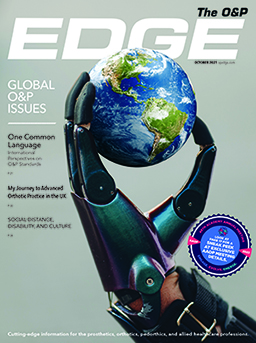Major Developments on O&P Research, Priorities, Policy and Funding
NAAOP Legislative Webcast: Major Developments on O&P Research, Priorities, Policy and Funding 5:24
June 02, 2016
NAAOP’s roots center on the issue of O&P research and development. In 1987, a small group of O&P leaders believed the field needed to develop a funding stream for O&P research activity and NAAOP’s predecessor organization, the American State of the Art Prosthetic Association, was born. The organization focused on introduction of the Claude Pepper Act for Amputees, which was eventually merged into the National Institutes of Health (NIH) Reauthorization Act of 1990. That law created a program at NIH known as the National Center for Medical Rehabilitation Research (NCMRR). The mission of the center is to “conduct and support medical rehabilitation research, including orthotic and prosthetic research and development.” The center has supported O&P research ever since, primarily through the Small Business Innovation Grant (SBIR) program, but also through more traditional NIH grants usually secured by large research universities.
NIH: Recently, twenty five years after passage of this law, NIH held a two-day rehabilitation research conference where nearly 500 people participated. O&P research priorities were discussed in the context of rehabilitation science. O&P research was clearly at the table and held its own in a manner that could not have been imagined 25 years ago. This conference will help NIH update its research priorities, which have not been updated since 1993. This conference and the research plan update were, in part, prompted by advocacy by the Disability and Rehab-ilitation Research Coalition (DRRC), a 43-member coalition in which NAAOP participates.
Interagency Committee on Disability Research (ICDR): DRRC was also successful in getting Congress to direct another federal entity, the ICDR, to develop a government-wide strategic plan for rehabilitation, disability and independent living. That broader effort is being conducted simultaneously with the NIH research plan process. Within the next few months, the federal government is expected to have two major documents that prioritize, coordinate, and elevate the stature of rehabilitation and disability research, with a meaningful focus on O&P research.
Evidence-Based Medicine: This is critical in that all of health care is moving at a rapid pace toward evidence-based medicine and evidence-based practice. A sufficient evidence base will be necessary in the future to secure coverage of O&P services that are often taken for granted today, and the research efforts of today will help pave the way to this. The O&P community has been proactive about evidence development for some time. Two research foundations were established by AOPA and the Academy. AOPA secured a large federal appropriation to fund O&P research through the Department of Defense, and the Academy developed consensus around a set of O&P research priorities as well as other efforts.
Washington Meetings with Research Agencies: The timing, therefore, could not be better for the next Alliance activity planned for mid-June. O&P researchers and Alliance leaders will meet with the heads of five different federal agencies responsible for funding O&P research over a two-day period. The agencies include NIH, ICDR, the National Science Foundation, the Department of Defense, and the Veterans Administration. The goal of the meetings is to further develop relationships with these funding agencies and exchange information on priorities and research portfolios. NAAOP will continue to keep you apprised of developments in this area.



























-
-
-
-
CONTACT US